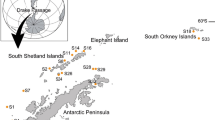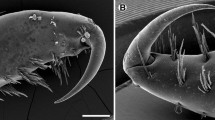Abstract
Burrowing mechanisms of the scalpellid barnacle Lithotrya dorsalis collected from Indian Key, Florida, USA and Fort Point, Jamaica, West Indies, in the fall and spring of 1983 and 1984 were investigated. Calcite spicules covering the peduncule of this animal mechanically abrade carbonate substratum and are described by light and scanning electron microscopy. These spicules undergo a morphological transformation during the molt cycle. Initial observations on the burrowing habit of L. dorsalis indicate that it also employs a chemical agent during bioerosion. Characteristic etching patterns on both optically pure calcite (Iceland spar) and shell material lend further support to this contention. Possible sources of this chemical agent are discussed.
Similar content being viewed by others
Literature cited
Ahr, W. M., Stanton, R. J. (1973). The sedimentologic and paleoecologic significance of Lithotrya, a rockboring barnacle. J. Sed. Pet. 43:20–23
Ansell, A. D., Nair, N. B. (1969). A comparative study of bivalves which bore mainly by mechanical means. Am. Zool. 9: 857–868
Bak, R. P. M. (1976). The growth of coral colonies and the importance of crustose coralline algae and burrowing sponges in relation with carbonate accumulation. Neth. J. Sea Res. 10: 285–337
Blake, J. A. (1969). Systematics and ecology of shell-boring polychaetes from New England. Am. Zool. 9:813–820
Blake, J. A., Evans, J. W. (1973). Polydora and related genera as borers in mollusk shells and other calcareous substrates. Veliger 15:235–250
Cannon, H. G. (1945). On the anatomy of the pedunculate barnacle Lithotrya. Phil. Trans. R. Soc. Lond. B. 233:12–136
Carriker, M. R. (1972). Observationson removal of spines by muricid gastropods during shell growth. Veliger 15:69–74
Carriker, M. R. (1978). Ultrastructural analysis of dissolution of shell of the bivalve Mytilus edulis by the accessory boring organ of the gastropod Urosalpinx cinerea. Mar. Biol. 48: 105–134
Carriker, M. R. Scott, D. B., Martin, G. N. (1963). Demineralization mechanism of gastropods. Publs. Am Ass. Advmt. Sci. 75: 55–89
Carriker, M. R., Smith, E. H. (1969). Comparative calcibiocavitology: summary and conclusions. Am. Zool. 9: 1011–1021
Carriker, M. R., Chauncey, H. H. (1973). Effect of carbonic anhydrase inhibition on shell penetration by the muricid gastropod Urosalpinx cinerea. Malacologia 12:247–264
Carriker, M. R., Williams, L. G. (1978). The chemical mechanism of shell dissolution by predatory boring gastropods: a review and an hypothesis. Malacologia 17: 143–156
Carriker, M. R., Williams, L. G., Van Zandt, D. (1978). Preliminary characterization of the secretion of the accessory boring organ of the shell penetrating muricid gastropod Urosalpinx cinerea. Malacologia 17: 125–142
Cobb, W. R. (1969). Penetration of calcium carbonate substrates by the boring spronge Cliona. Am. Zool. 9: 783–790
Darwin, C. (1851). A monograph on the subclass Cirripedia with figures of all the species. The Lepadidae; or pedunculated cirripeds. R. Soc. London
Davis, C. W., Fyhn, U. E. H., Fyhn, H. L. J. (1973). The intermolt cycle of cirripeds: critera for its stages and its duration in Balanus amphitrite. Biol. Bull. mar. biol. Lab., Woods Hole 145:310–322
Dineen, J. F. (1987a). The larval stages of Lithotrya dorsalis (Ellis and Solander, 1786): a burrowing thoracican barnacle. Biol. Bull. mar. biol. Lab., Woods Hole, 172: 284–298
Dineen, J. F. (1987b). Life history biology and functional morphology of Lithotrya dorsalis, a burrowing thoracican barnacle. Ph.D. Dissertation, University of Maryland, College Park, USA
Evans, J. W. (1969). Borers in the shell of the sea scallop, Placopecten magellanicus. Am. Zool. 9: 775–782
Focke, J. W. (1977). The effect of a potentially reef-building vermetid-coralline algal community on an eroding limestone coast, Curacao, Netherlands Antilles. Proc. 3rd int. Symp. coral Reefs, p. 239–245. [Taylor, D. L. (ed.) School of Marine and Atmospheric Sciences, University of Miami, Miami]
Friedman, G. M. (1959). Identification of carbonate minerals by staining methods. J. Sediment. Petrol. 29: 87–97
Halcrow, K. (1978). Modified pore canals in the cuticle of Gammarus (Crustacea: Amphipoda); a study by scanning and transmission electron microscopy. Tissue and Cell 10: 659–670
Hatch, W. I. (1980). The implication of carbonic anhydrase in the physiological mechanism of penatration of carbonate substrata by the marine burrowing sponge Cliona celata (Demospongiae). Biol. Bull. mar. biol. Lab., Woods Hole 159: 135–147
Hein, F. J., Risk, M. J. (1975). Bioerosion of coral heads: inner patch reefs, Florida reef tract. Bull. mar. Sci. 25: 133–138
Highsmith, R. C. (1981). Coral bioerosion at Enewetak: agents and dynamics. Int. Revue ges. Hydrobiol. 66: 335–375
Hubschman, J. H. (1962). A simplified azan process well suited for crustacean tissue. Stain Technol. 37: 379–380
Hutchings, P. A. (1986). Biological destruction of coral reefs. Coral Reefs 4: 239–252
MacGeachy, J.K., Stearn, C. W. (1976). Boring by macroorganisms in the coral Montastrea annularis on barbados reefs. Int. Revue ges. Hydrobiol. 61: 715–745
Mahmoud, M. F. (1957). The glands of the outer integument of the pedunculate cirripedes. Proc. Egypt. Acad. Sci. 13: 50–55
Meenakshi, V. R., Scheer, B. T. (1959). Acid mucopolysaccharide of the crustacean cuticle. Science, N.Y. 130: 1189–1190
Morton, B. (1986). The biology and functional morphology of the coral-boring Jouannetia cumingii (Bivlvia: Pholadacea). J. Zool. Lond. 208: 339–366
Pearse, A. G. (1953). Histochemistry theoretical and applied. Little Brown and Company, Boston
Pomponi, S. A. (1976). An ultrastructural study of boring sponge cells and excavated substrate. Proc. 9th Ann. SEM Symp. Pt. VIII, I.I.T. Res. Inst., Chicago, p. 569–575. [Johari, O. (ed.)]
Rice, M. E. (1969). Possible boring structures of the sipunculids. Am. Zool. 9: 803–812
Ride, M. E., Macintyre, I. G. (1972). A preliminary study of sipunculan burrows in rock thin sections. Carib. J. Sci. 12: 41–44
Risk, M. J., MacGeachy, J. K. (1978) Aspects of bioerosion of modern Caribbean reefs. Rev. Biol. Trop. 26: 85–105
Rutzler, K., Rieger, G.. (1973). Sponge burrowing: fine structure of Cliona lampa penetrating calcareous substrata. Mar. Biol. 21: 144–162
Sewell, R.B.S. (1926). A study of Lithotrya nicobarica Reinhardt. Rec. Indian Mus. 28: 269–330
Smarsh, A., Chauncey, H. H., Carriker, M. R., Person, P. (1969). Carbonic anhydrase in the accessory boring organ of the gastropod, Urosalpinx. Am. Zool. 9: 967–982
Spencer, T. (1985). Marine erosion rates and coastal morphology of reef limestones on Grand Cayman Island, West Indies. Coral Reefs 4: 59–70
Thomas H. J. (1944) Tegumental glands in the Cirripedia Thoracica. Quart. J. micr. Sci. 84: 257–281
Tomlinson, J. T. (1969). The burrowing barnacles (Cirripedia: Order Acrothoracica). Bull. U.S.natn. Mus. 269: 1–162
Travis, D. F. (1955). The molting cycle of the spiny lobster Panuliris argus Latreille. II. Pre-ecdysial histological and histochemical changes in the hepatopancreas and integumental tissues. Biol. Bull. mar. biol. Lab., Woods Hole 108: 88–112
Tzur, Y., Safriel, U. N. (1979). Vermetid platforms as indicators of coastal movements. Israel J. Earth Sci. 27: 124–127
Walley, L. J. (1967). The cirral glands: a new type of epidermal gland in cirripedes. Crustaceana 12: 151–158
Warme, J. E. (1975). Borings as trace fossils, and the processes of marine bioerosion. In: R. W. Frey (ed.). The study of trace fossils. Springer Verlag, New York, p. 181–227
Williams, J. A., Margolis, S. V. (1974). Sipunculid burrows in coral reefs: evidence for chemical and mechanical excavation. Pacific Sci. 28: 357–359
Yonge, C. M. (1963). Rock-boring organisms. Publs. Am. Ass. Advmt Sci. 75: 1–24
Zevina, G. B. (1981). Barnacles of the suborder Lepadomorpha (Cirripedia, Thoracica) of the world ocean. Part 1: Family Scalpellidae. Guides to the fauna of the USSR published by the Zoological Institute of the Academy of Sciences of the USSR, Leningrad, p. 1–406.
Zottoli, R. A., Carriker, M. R. (1974). Burrow morphology, tube formation, and microarchitecture of shell dissolution by the spionid polychaete Polydora websteri. Mar. Biol. 27: 307–316
Author information
Authors and Affiliations
Additional information
Communicated by J. Grassle, Woods Hole
Rights and permissions
About this article
Cite this article
Dineen, J.F. Functional morphology of Lithotrya dorsalis (Cirripedia: Thoracica) in relation to its burrowing habit. Marine Biology 98, 543–555 (1988). https://doi.org/10.1007/BF00391546
Accepted:
Issue Date:
DOI: https://doi.org/10.1007/BF00391546




